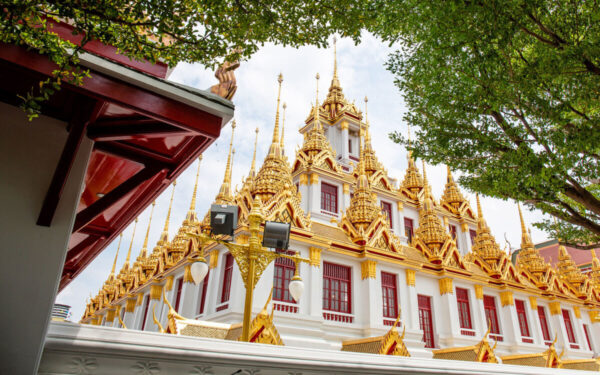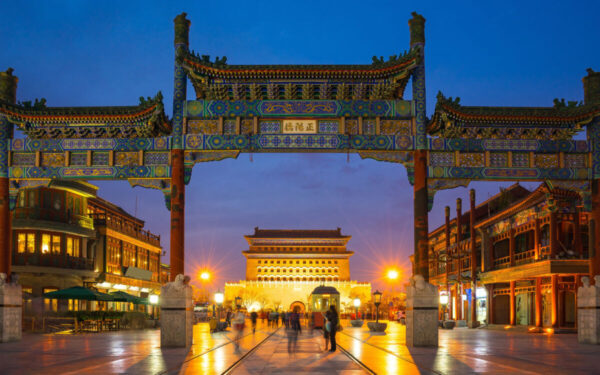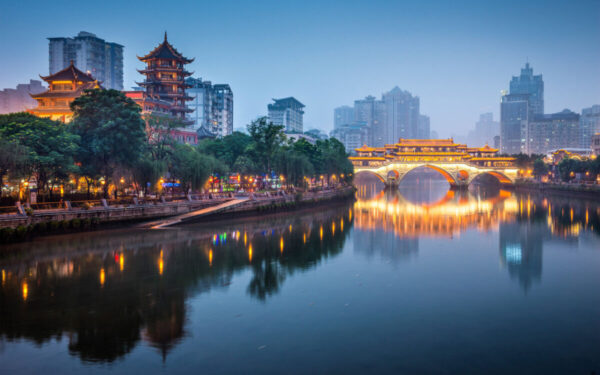Su Muon Pagoda Phu Quoc is a must-visit spiritual retreat, where lush greenery, sacred serenity, and traditional Vietnamese culture come together. Nestled on a tranquil hillside, this peaceful pagoda offers travelers a deeper connection to the island’s soul, beyond its beaches and resorts.
Nestled on a gentle hill along the scenic route from Duong Dong Town to Tranh Stream in Phu Quoc, Su Muon Pagoda Phu Quoc invites visitors to explore a space where lush tropical landscapes blend with ancient Buddhist traditions. This serene sanctuary is not only a sacred temple but also a symbol of Vietnam’s spiritual heritage, with its unique architecture and vibrant community life. Its convenient location makes it an easy and meaningful stop for travelers exploring the stunning Phu Quoc Island.
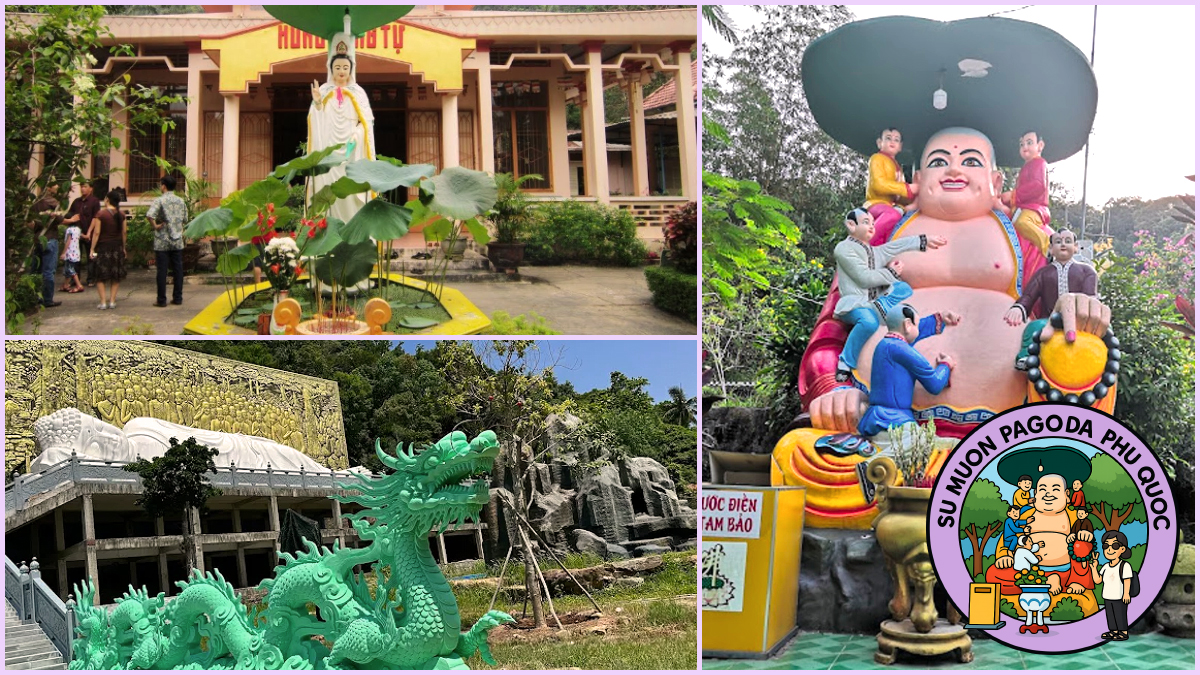
Whether you’re seeking a moment of tranquility away from the bustling beaches, looking to understand local legends, or simply in search of a stunning viewpoint to admire the island’s scenery, this destination is a must-visit. In this article from Asia Legend Travel, we’ll take you through everything you need to know about Su Muon Pagoda in Phu Quoc – from its rich history and cultural significance to practical details like the best times to visit, how to get there, what’s nearby, and essential tips for making the most of your visit.
History of Su Muon Pagoda Phu Quoc
Su Muon Pagoda Phu Quoc, also known as “Hùng Long Tự,” was founded in the early 1930s by the venerable Monk Nguyen Kim Mon. Locals began calling it “Su Muon Pagoda” as a tribute to its founder. It’s said that before devoting his life to Buddhism, Monk Nguyen Kim Mon had worked as a banker. After years of practicing and spreading Buddhist teachings on islands like Hon Thom and Tho Chu, he eventually settled on Phu Quoc, where he built the pagoda and gained the trust and following of many local residents.
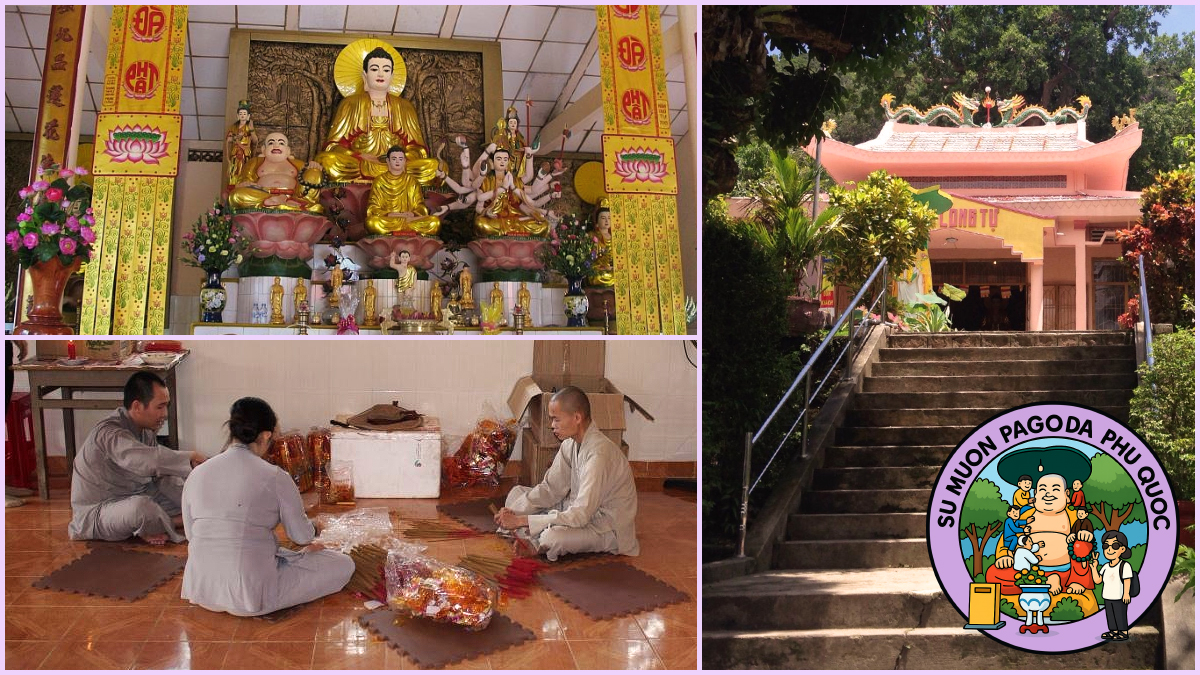
The history of Su Muon Pagoda Phu Quoc has been marked by both challenges and resilience. Around 1945, during times of conflict, the site suffered significant damage. It wasn’t until 1955 that the pagoda was rebuilt. During the wars against the French and later the Americans, the pagoda served a crucial role as a secret base—a place that supplied medicine, food, and acted as a liaison hub for the National Front for the Liberation of South Vietnam in the Phu Quoc area.
In the late 1990s, under the leadership of Abbot Thich Nhuan Duc, Su Muon Pagoda (Phu Quoc) saw its most extensive restoration and expansion. New meditation halls were built, a tall bell tower was added, and the hillside was transformed with serene terraced gardens—securing its place as one of Phu Quoc’s most significant spiritual and cultural landmarks.
>> Wallet-Friendly Finds: Phu Quoc Island Tour – 5 Days 4 Nights Itinerary!!
Highlight of Su Muon Pagoda Phu Quoc
When you arrive at Su Muon Pagoda Phu Quoc, you’ll be welcomed by a serene landscape where nature and architecture blend seamlessly together, creating one of the most remarkable cultural and spiritual destinations on this stunning island. Here’s what makes this sacred site so special:
- Peaceful Atmosphere Amid the Hills: Situated just 6 km from Duong Dong town, this tranquil pagoda sits halfway up Dien Tien Mountain. A beautiful stone stairway of 60 steps winds its way up through lush tropical vegetation. These steps hold special meaning in Buddhist tradition, representing the “lục thập hoa giáp” – the sixty-year cycle of human life. As you climb, you’ll find yourself entering a peaceful sanctuary away from the bustling town below, making it perfect for quiet reflection or meditation.
- Historical and Spiritual Significance: With a century-long history and significant role in local culture, Su Muon Pagoda in Phu Quoc remains an important spiritual sanctuary. Locals regularly visit to burn incense and seek blessings for health, prosperity, and inner peace.
- Ancient Trees and Sacred Vibes: Behind the main hall stands a 800-year-old Konia tree, under which lies a statue of Buddha. This shady spot is considered sacred, and many visitors meditate or pray here. Some believe the tree grants spiritual energy and blessings.
- Traditional Architectural Features: Throughout the grounds, the pagoda showcases an impressive collection of statues depicting Buddha, Avalokitesvara (Quan Âm), and other Buddhist deities. These sculptures beautifully blend traditional Buddhist iconography with distinctive Vietnamese artistic elements, offering visitors an authentic glimpse into the region’s rich spiritual heritage.
- Viewpoint Over Forest and Sea: From the top, visitors can enjoy sweeping views over the surrounding forests and coastline. It’s a popular spot for photography, especially in the early morning or late afternoon when the lighting softens the entire landscape.
- Less Touristy, More Authentic: Unlike some more commercial temples, Su Muon Pagoda (Phu Quoc) is calm and authentic, maintained by monks and local devotees. Visitors are welcomed respectfully, especially when dressed modestly and behaving reverently.

Monastic Life at Su Muon Pagoda Phu Quoc
A visit to Su Muon Pagoda Phu Quoc is not complete without observing the daily routines of its resident monks – the embodiment of Su Muon Pagoda monk life. Their disciplined yet serene schedule offers a peek into monastic simplicity:
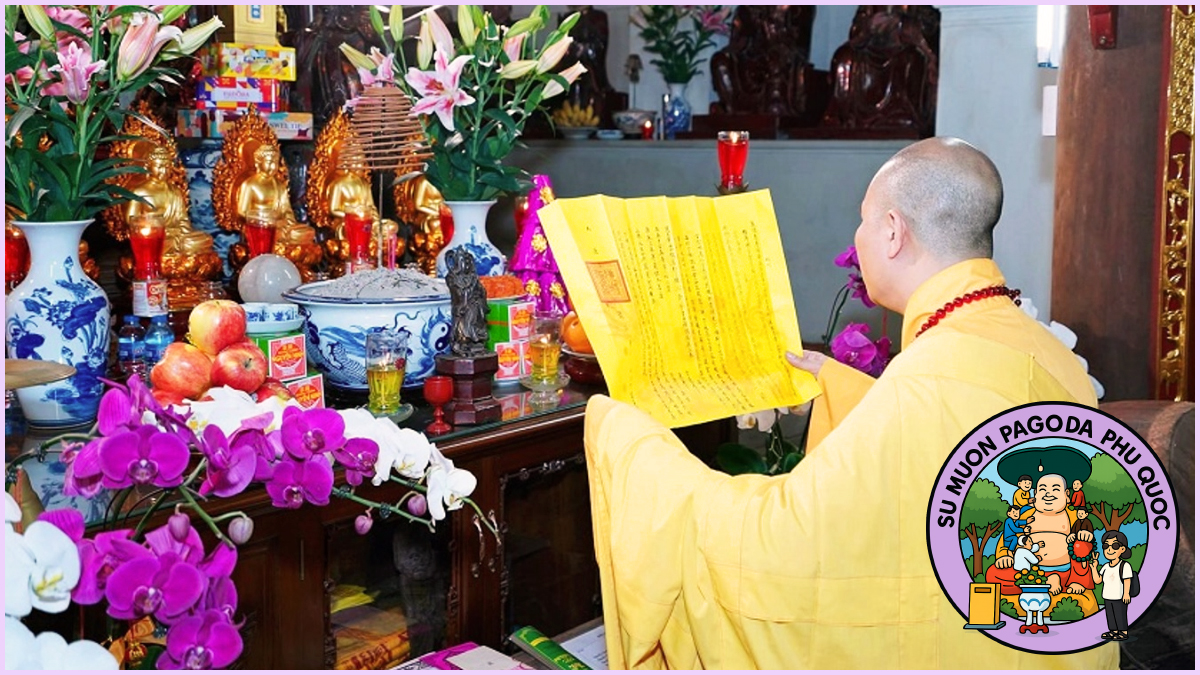
- 5:00 AM – Dawn Bell: The bell tower’s deep toll rouses both monks and early pilgrims. Dressed in plain brown robes, the monks convene for morning chant and meditation, their voices rising in gentle unison.
- 7:00 AM – Communal Breakfast: In the dining hall, vegetarian dishes – stir-fried greens, tofu stew, and rice – are shared in silence. Visitors are occasionally invited to join, learning the art of mindful eating.
- 9:00 AM – Alms Round: Walking the nearby village roads, monks carry alms bowls, accepting offerings of fruit and bread. “I once watched a novice monk receive a simple mango, yet his gratitude was profound,” recalls traveler James from Los Angeles.
- Noon – Rest and Study: After a light midday meal, monks study sutras in the library or maintain the gardens, pruning bonsai and tending lotus ponds.
- 4:00 PM – Afternoon Chant: A second round of chanting precedes teachings by the abbot, where visitors can listen to Dharma talks about compassion, impermanence, and the path to enlightenment.
- 6:00 PM – Evening Bell and Meditation: As dusk falls, the bell tolls again, inviting the community to a final meditation session. The pagoda’s lantern-lit corridors and shadowy stupas create a peaceful ambiance perfect for reflection.
Experiencing Su Muon Pagoda monk life provides travelers with not only insight into Buddhist practice but also inspiration to embrace mindfulness in their own lives.
>> Exclusive Discounts: Phu Quoc Island Tour – 3 Days 2 Nights!!
Best Time to Visit Su Muon Pagoda Phu Quoc
Understanding the Best Time to Visit Su Muon Pagoda Phu Quoc can greatly enhance your experience, ensuring you enjoy not only pleasant weather but also local festivals and the beauty of the surroundings. Here’s a breakdown of what you can expect throughout the year:

Dry Season (November – April)
The dry season, stretching from November to April, is undoubtedly the most popular time to visit Su Muon Pagoda in Phu Quoc. During this period, you’ll enjoy sunny skies, low humidity, and comfortable temperatures ranging from 25°C to 30°C (77°F–86°F). The early mornings and late afternoons are perfect for exploring the outdoor areas of the pagoda. The soft, golden light of the sunrise and sunset enhances the intricate stone carvings and peaceful ambiance, making it an ideal time for photography or meditation. The dry weather also ensures that the surrounding rainforest trails are accessible, offering a peaceful and refreshing hike.
Rainy Season (June – September)
From June to September, the rainy season settles over Phu Quoc, with afternoon downpours and occasional storms being common. While some of the rural roads might flood, Su Muon Pagoda (Phu Quoc) remains accessible, and the rain enhances the tropical ambiance. The lush rainforest surrounding the pagoda becomes even more vibrant, and the sound of raindrops on the pagoda’s roof creates a serene atmosphere that’s perfect for those seeking tranquility. Keep in mind that the rain can make outdoor activities a bit challenging, but it also means that you’ll experience the island in its most lush, verdant state.
Quieter Months to Visit (May & October)
If you’re looking to skip the peak-season crowds while still enjoying pleasant weather, May and October are great times to plan your trip to Phu Quoc. These months sit just outside the island’s busiest tourist periods, offering a more relaxed atmosphere. While you may experience the occasional light afternoon shower, the rain tends to be short-lived – and it brings the landscape to life.
The forest surrounding Su Muon Pagoda Phu Quoc becomes a shimmering sea of green, with dewdrops glistening on the leaves and vibrant foliage all around. Fewer visitors also mean quieter temple grounds, more opportunities for serene photos, and better deals on hotels and tours – perfect for travelers who appreciate peace, beauty, and value.
Festival Times in Phu Quoc
Several traditional festivals take place throughout the year and add a rich cultural layer to your visit to Su Muon Pagoda Phu Quoc:
- Lunar New Year (Tết) – Late January or early February: During Tet holiday, Su Muon Pagoda in Phu Quoc becomes especially vibrant with incense, flower offerings, and early-morning prayers. Locals come to the temple to seek blessings for the new year.
- Vu Lan Festival – 7th lunar month (usually August): Known as the Ghost Festival, this Buddhist event honors parents and ancestors. Su Muon Pagoda (Phu Quoc) hosts special chanting ceremonies and lantern offerings, creating a moving and spiritual atmosphere.
- Dinh Cau Festival (near Dinh Cau Temple) – November: While not held at Su Muon Pagoda (Phu Quoc) directly, this nearby celebration includes boat races, folk performances, and seafood feasts, making it a great cultural pairing with a visit to the pagoda.
If your travel dates coincide with one of these events, expect a deeper cultural connection—and larger crowds—especially in the mornings.
Traveler Tip: “Visiting in February was perfect – cool mornings for meditation and sunny afternoons for exploring the stupas,” recalls Priya from Singapore, who found the weather ideal for both relaxation and exploration.
How to Get to Su Muon Pagoda Phu Quoc
Planning How to Get to Su Muon Pagoda Phu Quoc is straightforward – several convenient options connect you from key points on the island:
- From Phu Quoc International Airport (PQC): A 20-minute taxi ride (approx. 160,000-180,000 VND) takes you directly to the pagoda’s entrance. Taxis are available 24/7 outside the arrival hall.
- From Duong Dong Town: Rent a motorbike (150,000 VND/day) or bicycle (50,000 VND/day) for a scenic 6-km ride east. Follow the coastal road, then turn inland at the signposts for Su Muon Pagoda (Phu Quoc).
- By VinBus Shuttle: The free VinBus service runs between major attractions on Phu Quoc Island, check the schedule at Vinbus Phu Quoc
- Private Car or Tour: Many local tour operators include Su Muon Pagoda in Phu Quoc in half-day or full-day island tours, often combined with Dinh Cau Beach and Ham Ninh Village stops.
No matter which route you choose, the journey to Su Muon Pagoda Phu Quoc offers glimpses of Phu Quoc’s lush countryside – so keep your camera ready!
Attractions Nearby Su Muon Pagada Phu Quoc
While Su Muon Pagoda Phu Quoc offers a peaceful and spiritual experience, there are plenty of exciting activities and attractions nearby to enrich your Phu Quoc Island tour. From tranquil beaches to lively markets, here’s a guide to some of the best things to do near the pagoda:
Suoi Tranh Waterfall (~4 km)
Just a short drive from Su Muon Pagoda, Tranh Stream in Phu Quoc (Suoi Tranh Waterfall) is one of the most accessible natural attractions on the island. Set within a landscaped park surrounded by lush jungle, the stream flows through mossy rocks and bamboo groves before cascading into a gentle, photogenic waterfall. The walk to the falls takes about 15 minutes along a well-marked forest path, making it suitable for most visitors.
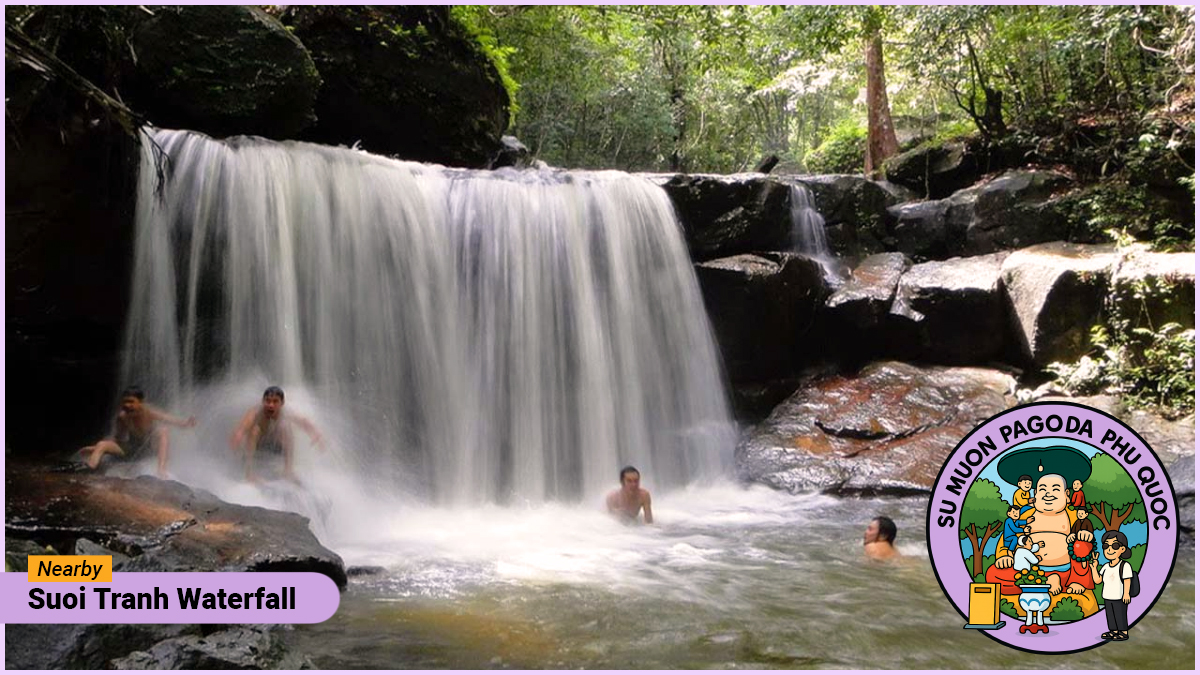
Along the way, you’ll pass peaceful picnic spots, colorful orchids, and small cave formations. Best visited during the rainy season (June–October), Suoi Tranh offers a cool, refreshing break from the tropical heat—perfect for relaxing in nature or capturing quiet moments on camera.
Dinh Cau Beach (6 km)
Just a short 10-minute drive from the pagoda, Dinh Cau Beach in Phu Quoc is famous for its breathtaking sunsets. The beach is a local favorite, where you can witness fishermen casting their nets as the golden sun dips below the horizon. Don’t forget to indulge in a local delicacy: freshly grilled prawns, seasoned with the famous Phu Quoc pepper, available at nearby beachfront restaurants. The view of the iconic Dinh Cau Rock and the pagoda from the beach makes it a perfect spot for photos and relaxation.
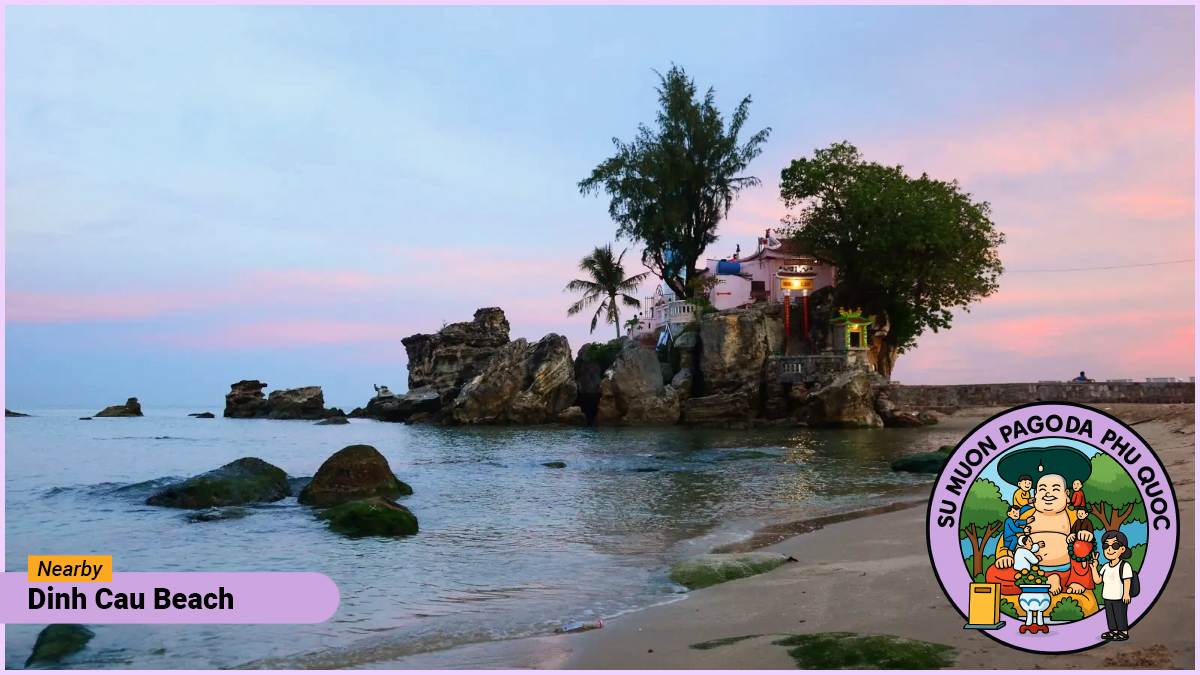
Ham Ninh Fishing Village (10 km)
Located about a 20-minute drive northeast from the pagoda, Ham Ninh Fishing Village offers a step back in time. Here, you’ll find charming wooden stilt houses perched along the shore, with fishermen going about their daily routines. The village is renowned for its fresh seafood, and the local specialty is crayfish hotpot – a savory and aromatic dish perfect for those who enjoy a hearty meal. As you dine, you can listen to the fishermen’s captivating sea tales, sharing stories about the ocean and their lives on the island. The peaceful setting and authentic atmosphere make Hàm Ninh a perfect escape from the busy tourist spots.
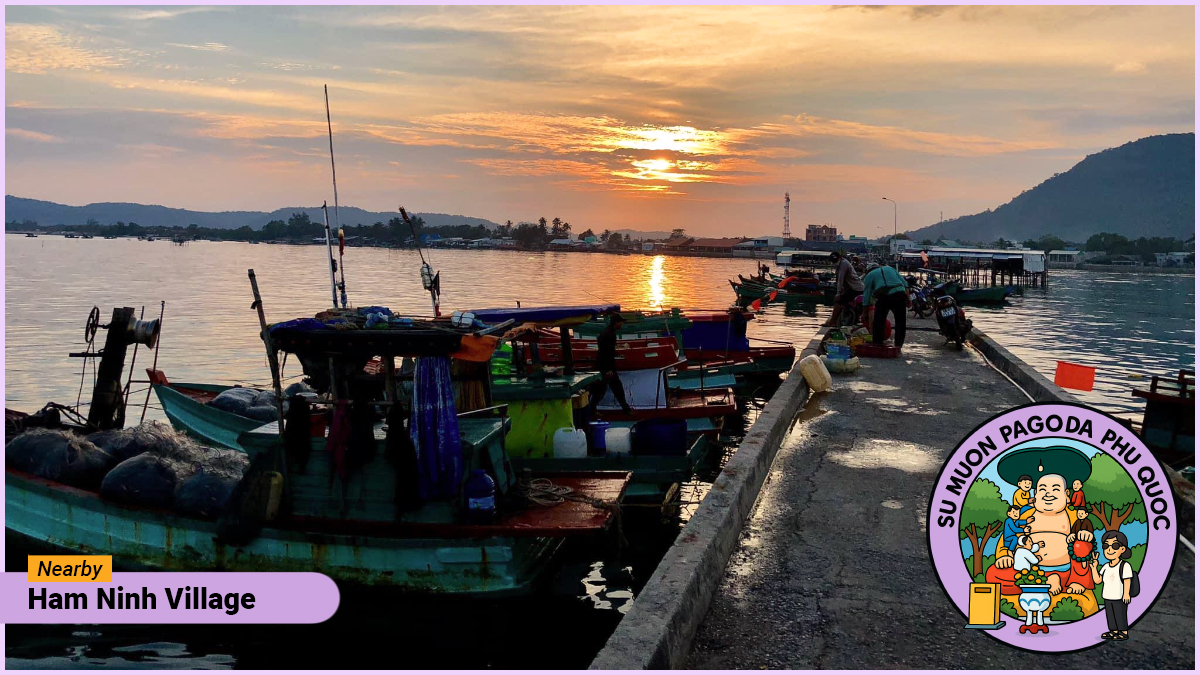
Phu Quoc Night Market (6 km)
As the sun sets, head to Phu Quoc Night Market, a must-visit for food lovers. Only a 15-minute drive from the pagoda, the market comes alive with colorful lanterns and the hustle and bustle of local vendors. Sample the island’s culinary delights, such as banh khot (mini savory pancakes) filled with shrimp and vegetables, or try goi ca trich (sliced mackerel salad), a signature dish of Phu Quoc. Quench your thirst with fresh sugarcane juice, a popular drink enjoyed by locals and visitors alike. The lively atmosphere and vibrant street food stalls make this market a true highlight of the island’s culture.
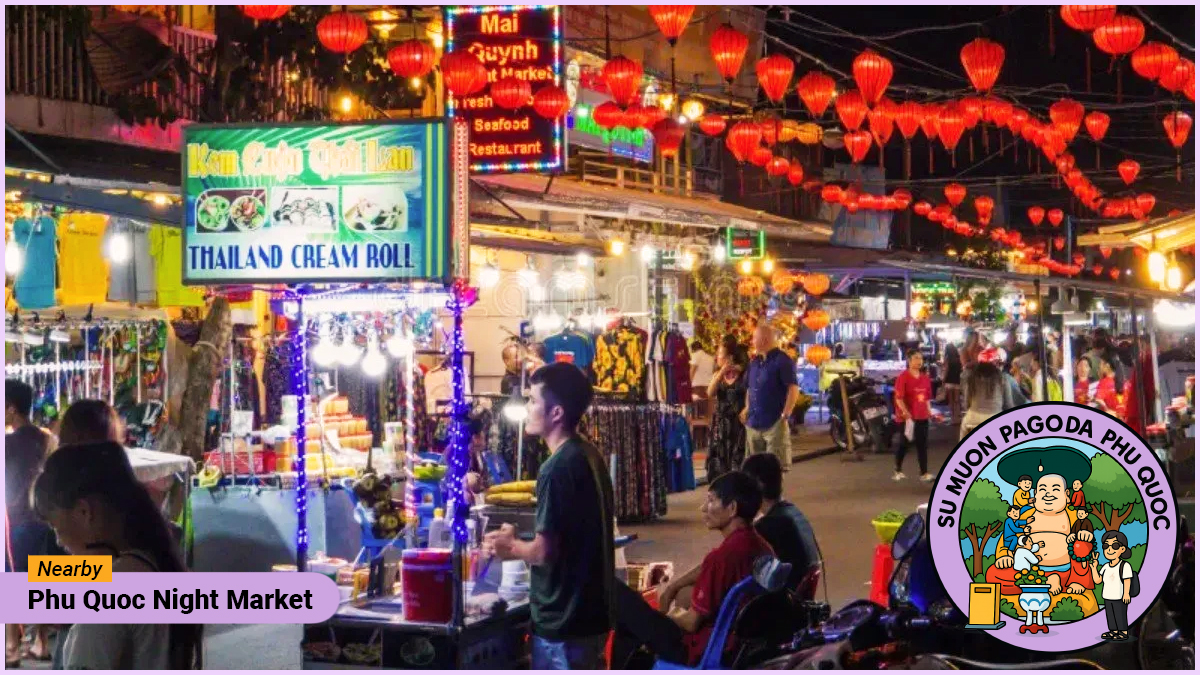
Da Ban Stream Phu Quoc (~10 km)
Tucked away in the lush interior of Phu Quoc National Park, just a 15-minute drive from Su Muon Pagoda Phu Quoc, Da Ban Stream in Phu Quoc (Suối Đá Bàn) is a quiet escape for nature lovers. The stream gently flows over wide, flat granite rocks—hence the name—and forms calm, shallow pools where you can dip your feet and relax. Surrounded by dense forest, it’s an ideal spot for a peaceful picnic or a leisurely walk along shaded jungle trails. For the best experience, visit during the rainy season (June to October), when the water is at its most vibrant and the forest comes alive with tropical sounds and greenery.
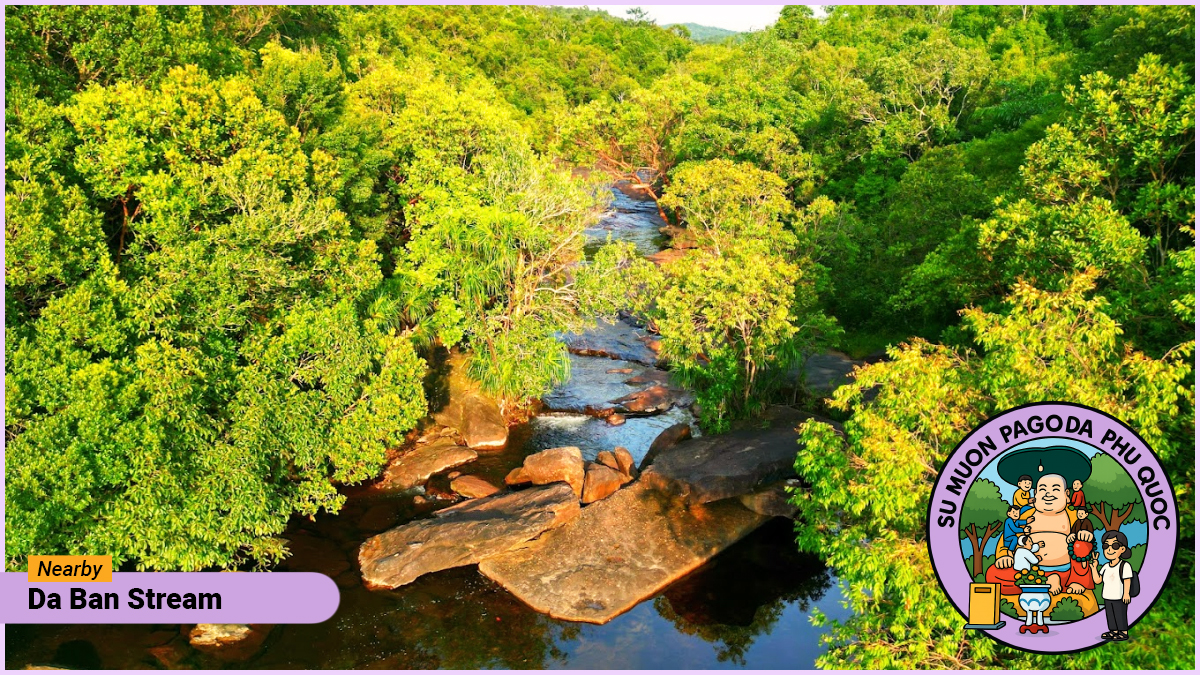
Vinpearl Safari (~30 km)
If you’re traveling with family or are a wildlife enthusiast, a trip to Vinpearl Safari in Phu Quoc is an exciting addition to your Phu Quoc itinerary. Situated about a 40-minute drive from the pagoda, the safari offers a chance to see exotic animals in a natural, open-air setting. The park is home to giraffes, tigers, elephants, and a wide variety of other animals from around the world. It’s a great place for both learning and adventure, with plenty of opportunities for close-up encounters with wildlife. You can also participate in feeding sessions and interactive experiences that are both educational and fun.

By combining these nearby attractions, you’ll be able to experience a full range of Phu Quoc’s cultural and natural treasures, from tranquil beach moments to vibrant markets and stunning nature trails. Whether you’re seeking adventure, relaxation, or a deep dive into local traditions, these activities will help you make the most of your time on the island.
Su Muon Pagoda Travel Tips
To make your journey to Su Muon Pagoda Phu Quoc both respectful and enriching, it’s worth knowing a few key local customs and practical tips. Whether you’re a seasoned traveler or exploring Vietnam for the first time, these pointers will help ensure a meaningful experience:

Dress Modestly, Dress Mindfully
Su Muon Pagoda (Phu Quoc) is an active place of worship where local monks and visitors come to meditate and reflect. Out of respect for the sacred atmosphere, it’s best to dress conservatively. This means covering your shoulders and knees. Lightweight, breathable fabrics are your best friend in Phu Quoc’s tropical heat. For women, a light shawl or sarong can be a great addition – easy to pack, and handy when needed.
Footwear Etiquette: Slip On, Slip Off
Before entering the pagoda’s main hall or any inner sanctum, you’ll need to remove your shoes. Flip-flops or slip-on sandals are the most convenient option, especially if you’re visiting multiple temples during the day.
Tip: Bring a small bag to carry your shoes, especially if you’re worried about leaving them unattended.
Photograph with Care
Vietnamese Buddhist culture values quiet reflection and personal privacy, especially in sacred spaces. Feel free to photograph the beautiful architecture, statues, and courtyards – but be mindful of your surroundings. If you’d like to take a photo of a monk or someone praying, always ask for permission first. Also, turn off your flash inside the main shrine to preserve the peaceful ambiance.
Stay Hydrated & Sun-Smart
The tropical sun in Phu Quoc can be surprisingly intense – even on cloudy days. Bring a refillable water bottle (many cafés nearby will refill it for free or a small charge), and use reef-safe sunscreen to protect both your skin and the island’s environment. A wide-brim hat and sunglasses are also smart accessories.
Respect Sacred Silence
The daily chanting sessions – from 5:00–6:00 AM and again from 6:00-7:00 PM – are deeply spiritual moments for the local community. If you happen to be visiting during these times, maintain a hushed tone or observe in silence. Listening to the rhythmic chanting in the early morning mist is an experience many travelers find unexpectedly moving.
Make a Thoughtful Offering
While donations are not required, visitors often choose to make a small contribution as a sign of respect and appreciation. You can leave a few Vietnamese dong in the donation box, or offer simple items like incense sticks, fresh flowers, or tropical fruits such as bananas or rambutans. These gestures help maintain the pagoda and support the monks’ daily life.
Plan a Full Day: Combine Nearby Attractions
Make your trip even more memorable by exploring what’s nearby. After your visit to Su Muon Pagoda in Phu Quoc, consider heading just 6 km west to Dinh Cau Beach for a stunning sunset where fishing boats float against a golden sky. Later in the evening, take a stroll through Phu Quoc Night Market, where you can sample sizzling street food like banh khot and shop for locally made souvenirs.
A Traveler’s Note
“I visited Su Muon just before sunset, and the soft light filtering through the trees felt almost otherworldly. The gentle chanting of the monks in the background was the most peaceful sound I’ve heard all trip. I left with a deep sense of calm I didn’t expect.” — Alex, California
By following these Su Muon Pagoda travel tips, you’ll not only show respect for local traditions but also create space for genuine connection – with the culture, the people, and yourself.
Conclusion: Is Su Muon Pagada Phu Quoc Worth-Visiting?
From its storied past and humble architecture to the enchanting legends and the peaceful rhythm of daily monastic life, Su Muon Pagoda Phu Quoc is a must-see on any journey to the island. Whether you’re drawn by the promise of quiet meditation, cultural discovery, or simply the beauty of a hilltop view, this spiritual heart of the Emerald Isle offers a truly enriching experience.
Ready to uncover the soul of Phu Quoc? Pack your sense of wonder, respect local customs, and set off to experience the quiet magic of Su Muon Pagoda (Phu Quoc). Book your accommodations in Duong Dong Town, plan your transfer, and prepare for a journey that will enrich your mind, body, and spirit.
Plan your visit today and discover why Su Muon Pagoda in Phu Quoc is considered the sacred heart of Phu Quoc’s culture and nature. Let this serene hilltop temple be more than just a stop on your itinerary—let it be a moment of peace in your journey.






